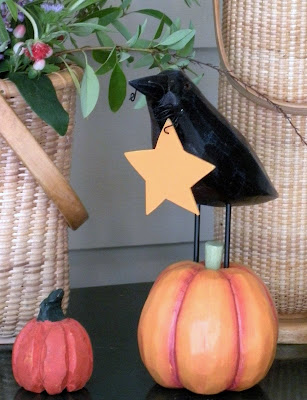
A recent trip to Baltimore and Wilmington
garnered a few treasures that have found their way
into fall vignettes here at HFTS.
Antique Majolica in Various Leaf Patterns
Vintage Binoculars with Leather Details
Scherenschnitte is the art of paper cutting. The tradition of scissor cutting was brought to Colonial America in the 18th century, primarily in Pennsylvania. A 1930s Quimper pitcher holds a fall bouquet, while a wooden blackbird and wooden pumpkins finish out the vignette.

As with this piece, these works of paper cuttings often have symmetry of design. Here fall leaves radiate off from a Tom Turkey. Acorns, owls, pumpkins, and black crows further embellish the design.
All these intricate details immediately
drew me to this piece, along with the beautiful fall colors
that were hand water colored.
And since black crows play a major roll in my new paper cut, I thought I'd include a few more crow inspired vignettes I created last year when I shared the following Native American legend that I taught my students in the fall of each year.
It was believed that in ancient times, all crows were as white as the snow. The native Americans that roamed the plains in search of buffalo hunted on foot. It was a difficult life, and the people depended on the buffalo to survive. They used every part of the buffalo for food, clothing, tools, and shelter.
The crows were friends of the buffalo, and as they soared high above they could see everything that happened below on the prairie. When they spied hunters approaching a herd, the crows would swoop down to the buffalo and call out in warning: "Caw, caw, caw. The hunters are near. You must run." The buffalo would scatter and leave the hunters without a kill. With time the people began to starve.
Among the crows was one that was larger than the others and the leader of the flock. The people decided that they must capture this big white crow and teach him a lesson. They devised a plan.
A young brave would wear a buffalo skin with head and horns. He would graze among the buffalo as if he were one of them. As the hunters approached, the crow called out his usual warning: "Caw, caw, caw. The hunters are near. You must run." All but one of the buffalo stampeded away. So the crow flew down and perched on the lone buffalo saying: "Caw, caw, caw. Can you not hear? The hunters are near. You must run and save yourself."
The brave then reached up from under his disguise and grabbed the crow. He tied a cord to his legs and attached the other end of the cord to a large stone. The crow was captured!

The people met again to decide what to do with this bad crow who was causing them to go hungry. As they gathered, one impatient brave grabbed the crow and threw him into the council fire. At once the fire burned through the cord, and the big crow flew to freedom.

But the big crow's beautiful white feathers were now black from the fire, and as he soared above the people could hear him call: "Caw, caw, caw. I'll never warn the buffalo again."
 You might be interested to know that crows are very intelligent birds and can mimic sounds. These large birds are often a problem for farmers and gardeners because they tend to live in large flocks which consume large amounts of food.
You might be interested to know that crows are very intelligent birds and can mimic sounds. These large birds are often a problem for farmers and gardeners because they tend to live in large flocks which consume large amounts of food.
Happy Thanksgiving!





































.PNG)













.JPG)














.jpg)












































































.jpg)






